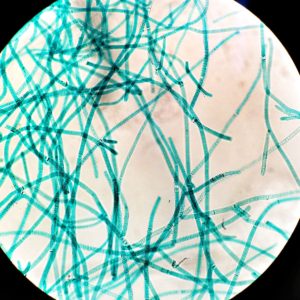
Algae Blooms
Year round, Utah Lake plays host to a whole family of microorganisms. In specific amounts, they all serve a benefit to the lake and the other organisms that call it home. However, too much of anything can be a bad thing. This is the case with the little microorganism called cyanobacteria, AKA blue-green algae — the stuff that causes the algae blooms in the summer.
While culturally recognized as algae, these little guys are actually a type of bacteria. They get the name cyanobacteria from their distinct light blue color. What sets cyanobacteria apart from most other types of bacteria is its ability to photosynthesize like a plant which means they are able to produce their own food from sunlight.
Cyanobacteria live in almost every ecosystem on Earth. They have been found in deserts, Antarctica, almost any damp soil, and even in the fur of sloths. That they can be found from pole to pole is a testament to cyanobacteria’s adaptability. They are a stunning example of life’s adaptability and richness. Some scientists even say that cyanobacteria are the most successful group of microorganisms on Earth.
Even though cyanobacteria can be found everywhere, they prefer the warm, still waters of lakes and ponds. So it shouldn’t come as any surprise then that cyanobacteria, like any other resident of Utah Valley, loves Utah Lake. Though, it should be noted that cyanobacteria and their subsequent blooms are found all throughout the lakes of the world. Utah Lake is special for many reasons, but not because of algae blooms.
While potentially harmful in certain amounts, cyanobacteria actually play a helpful role in the environment. Because they photosynthesize, they produce oxygen. And because they can be found in large numbers, they contribute significantly to the oxygen cycle. Meaning that having cyanobacteria in Utah Lake can be like having a massive field of oxygen producing grass for the valley.
But given the right conditions, cyanobacteria can multiply rapidly and create blooms that can become problematic. However, there are still a lot of questions surround cyanobacteria blooms in Utah Lake. What are the right conditions for algae blooms? Are blooms happening more often? Are they getting worse? Can anything be done to prevent them?
What follows is a comprehensive examination of the cyanobacteria that graces Utah Lake. We’ll look at what cyanobacteria need to thrive, why they bloom, what cyanobacterial toxicity is, and dissect the different algae warning levels. Become a Utah Lake algae bloom expert in 10 minutes or less by chewing on this heaping dose of savory knowledge
Causes of Blooms
Cyanobacterial blooms are a result of a combination of factors in the environment — nutrients, temperature, light, and turbidity. However, the variable nature of all these factors makes it impossible to determine which single one is most important. They all contribute and play off each other in order to create the right conditions for cyanobacteria to bloom.
Nutrients
Because cyanobacteria are a lot like plants, they need nutrients like nitrogen and phosphate to photosynthesize. And those nutrients are plentifully available in almost every body of water near a rural or urban area. This is due to our heavy usage of fertilizers in farms, gardens, and lawns. Anytime it rains or our sprinklers drain off into the gutter, massive amounts of nutrients are carried in the sewer which eventually runs into Utah Lake. Combine this with all the nutrients that are already being carried in from wind deposition and by Provo, American Fork, and Spanish Fork rivers along with Hobble and Currant creeks and you get an extremely nutrient dense Utah Lake.
In fact, during the summer, Utah Lake becomes hypereutrophic. That is a fancy word for saying that the nutrient load in the water can be off the charts. This excess can be problematic when a single organism, like cyanobacteria, is able to utilize the massive amounts of available nutrients to multiply at unchecked rates and create blooms.
Temperature
Here is where cyanobacteria get a competitive advantage over other forms of algae that live in Utah Lake. The more common types of algae prefer water temperature to be around 50℉. Cyanobacteria, on the other hand, loves water over 75℉.
Utah Lake summer water temperatures are comfortably warm in comparison to neighboring reservoirs like Deer Creek. This is due mostly to the shallowness of the lake. At an average depth of 10ft, the summer sun can more easily heat the water. This warmth can make it hard for other forms of algae or microorganisms to take hold, but it is perfect for cyanobacteria.
But this is not always a hard and fast rule. Remember that cyanobacteria have been found in every temperature zone on Earth from volcanic vents in the ocean to icy Antarctic rocks. So having warm water temperatures doesn’t guarantee a bloom, but it sure greases the wheels.
Light and Turbidity
Like all organisms that photosynthesize, sunlight is an important factor. Cyanobacteria depend on sunlight for food. However, they depend on a sweet spot between too much and too little. When exposed to high-intensity light for long periods, Cyanobacteria aren’t able to multiply as rapidly. The inverse is also true that when Cyanobacteria is deprived of sunlight, they aren’t able to multiply.
The reason water is such a suitable habitat for Cyanobacteria is that light is reflected and refracted enough while passing through to provide this goldilocks zone of light exposure. However, Utah Lake is an extra variable thrown in that the Cyanobacteria has to deal with — water turbidity.
When water is turbid it means that there is a large amount of suspended matter. This suspended matter, such as sediment and decay, keeps the sunlight from penetrating very deep in the water. This can disrupt the cyanobacteria’s dependence on sunlight and hinder a bloom. The water is too ‘dark’ to photosynthesize in.
Utah Lake is also a very windy place. Another side effect of being shallow is that the lake can get really choppy in windy conditions. This intense wave action churns and mixes the water keeping it turbid and further prevents the cyanobacteria from multiplying rapidly.
Water turbidity and its effect on algae blooms is one aspect of Utah Lake that requires further study.
Prediction
While scientists might understand some of the environmental factors involved in blooms, it is impossible to predict when and if one will occur. In environmental systems, like Utah Lake, there are an unfathomable amount of known and unknown variables. Nutrients, temperature, light, and turbidity just happen to be four of the biggest factors. All of them can be present in the right amounts for algae to bloom, but no bloom will occur. At the same time, none of these blooming conditions could be present and a bloom could still happen.
There are some tests underway with satellite imaging that we are hoping can provide enough data to predict algae blooms, but those are still in the test phase. At the moment, the best we can do is continue to observe and study this peculiar event that happens in lakes all around the world in an effort to safely coexist with our cyanobacterial neighbors.
Prevention
Can algae blooms be prevented? This is a hard question because it involves many many factors such as the ones listed above. Utah Lake is a huge and immensely complex ecosystem. Any project that could take on the prevention of cyanobacterial blooms on Utah Lake would require a level of capital and expertise very few organizations would be able to achieve. Yes, it might be theoretically possible to prevent blooms but it is almost a logistical impossibility.
Asking if we can prevent algae blooms also raises another question of should we be preventing algae blooms considering how little is known about the water quality history of Utah Lake. What we do know is that Cyanobacteria has been blooming on Utah Lake for at least the last century. It has only been in the last few years that they have been on the public’s radar. At the moment it is unknown whether preventing algae blooms would precipitate other problems in the lake that we are presently unequipped to deal with.
So beyond exploring new ways to farm or garden utilizing less fertilization, the conversation around bloom prevention is largely moot. Until we know more about Utah Lake’s historical water quality, any effort to do so could potentially be nearsighted.
Isolation
When algae blooms occur in one area of the lake, the bloom can be largely isolated to that one area. This is why it’s important to listen to the details of an algae bloom warning. The reason blooms tend to be isolated events goes back to Utah Lake being so large. Such a massive body of water is comprised of multiple ecosystems that change and fluctuate depending on the area.
For instance, the north end of the lake has many thermal vents that make the temperature fluctuate dramatically. A scientist even SCUBA dived into one of these vents 63 ft and didn’t find a bottom. But the south end of Utah Lake is surrounded by farmland which can make nutrient levels go up. And then Provo Bay is virtually its own little ecosystem.
All of this ecosystem variety means that algae have a hard time moving from one end of the lake to the other. On top of that, the cyanotoxin produced by the algae is found primarily in the floating mats rather than diffuse within the water. So one specific area could be experiencing a toxic bloom while another specific area could be clean enough to drink. This is why it’s important to understand where a bloom is happening so you don’t have to cancel your weekend plans.
Bloom Toxicity
One of the only reasons Cyanobacteria algal blooms are a point of conversation is because of the potential of a harmful algal bloom. When blooming in high enough concentrations, Cyanobacteria can sometimes produce cyanotoxins. These toxins can be harmful to fish, animals, or humans who ingest too much. In some cases, water toxicity can cause mass fish die-off events.
Something to be aware of is that algae blooms in Utah Lake are relatively tame in comparison to the blooms that happen in other parts of the country. Red Tides that happen on both the East and West coast can cause seizures. The Great Lakes region has suffered from quite a few blooms that prevented residents from using their tap water. So within the context of algae blooms around the country, Utah Lake is hardly notable.
It is important to note that toxins will not always be present in an algae bloom. When a bloom is found there is no guarantee that the cyanobacteria will be producing cyanotoxin. As was said before, algae blooms are a complex process. They are the culmination of many variables and ecological processes growing out of each other. As such, there will always be unknowns with each bloom.
In lake areas experiencing an algae bloom, toxins are found in highest and potentially dangerous concentrations within the floating green mats of algae. These often get bunched up along shorelines. In the absence of cyanotoxins, algae can be a mild allergen. Because a fraction of the population could have an allergic reaction to contact with concentrated algae, public notices are made even in the absence of toxins. In fact, even if there are toxins present, they aren’t absorbed through the skin.
The primary issue of concern are cyanotoxins which are microcystins, a liver toxin, anatoxin, a neurotoxin, and cylindrospermopsin, which can block protein synthesis. Of the three, the most prominent is microcystin. Simple contact with the skin is not enough for microcystin to make someone sick — it needs to be ingested. So if you see a floating algae mat, the last thing you want to do is put it in your mouth.
Cyanotoxin Lethality
But the most salient question regarding cyanotoxin is regarding its lethality. Can an algal bloom cost you your life? We will answer that question by listing activities that have a higher body count than algae blooms. Icicles falling on you. Vending machine falling on you. Coconuts falling on you. Your TV falling on you. Falling out of bed. Texting while driving. Driving on I-15. Shopping on Black Friday. Eating hot dogs. And the list goes on….
To date, no single person has ever died from exposure to cyanotoxins found in algae blooms in the United States. And the only deaths in the worldwide statistics come from algae-tainted water given intravenously through dialysis to a sick, elderly person. While it is theoretically possible to receive of a lethal dose of microcystin from natural exposure while swimming, it has never actually happened. The worst symptoms cyanotoxin exposure has manifested in the United States are akin to food poisoning — not fun, but also not lethal.
However, just because no one has, does not mean no one ever will. But it is important to consider the relative risks of our day-to-day behavior. There are far more dangerous activities we do every day without thinking. Algae blooms on Utah Lake are considerably safer than driving your kids to school.
Warning Levels

When officials become aware of a suspected algal bloom, the water is tested immediately. What officials are looking for are cyanobacterial cell concentration, microcystin levels, cylindrospermopsin levels, and anatoxin-a levels. If only a single one of these criteria thresholds are met, a warning is issued — even in the absence of the others. So, in the event that a public notice has been issued, it can be a bit tricky to decipher just what the notice levels mean.
The first level of public notice is a Warning with a moderate risk level. Of course, the risk level is dependent on whether any cyanotoxins have been detected. As stated above, it is entirely possible for a Warning to be issued in the absence of any cyanotoxins. If cell concentrations reach 20,000 cells per milliliter of water, the algae could be an allergic irritant. Mild itching could occur as well as the development of hives, but that’s if you’re rubbing the floating mats on your skin. So, if you see the floating cyanobacteria, don’t to that. Otherwise, if there has been toxin detected, it’s best to not eat the algae or drink the water.
With a Warning, the specific area is not closed to the public. This is a common misunderstanding. Remember, simple skin contact with algae is potentially allergenic to a fraction of the population. But in the case of cyanotoxins, they could only possibly be harmful if they are ingested. Simple skin contact with algae blooming water is not enough. In fact, it’s nearly harmless. So when a Warning level has been issued, the public can still recreate in the water. It just means to be more careful you aren’t drinking the water, rubbing the algae on your skin, or eating it.
The second level of public notice is a Danger notice. Danger obviously comes with a higher risk level. At this point, the specific area officially becomes closed to the public. It wouldn’t be smart to swim in the closed water because you could be in for a rough weekend of cramps, vomiting, and diarrhea. So if there’s a Danger notice on a specific area, stay out of it.
More Algae Info
If there are any questions left unanswered, please don’t hesitate to contact us at the Utah Lake Commission. Also be sure to visit Utah’s Division of Water Quality to stay up to date on active algae blooms. They have maps of active blooms as well as data on specific levels of toxins vs cell counts.
